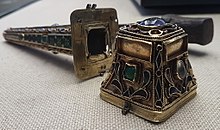Andreas portable altar
The Andreas portable altar or Egbert shrine is a box-shaped collective reliquary that is kept in Trier Cathedral . It is one of the most important works of Ottonian goldsmithing.
The reliquary was made in the Trier Egbert workshops on behalf of Archbishop Egbert von Trier , who is inscribed as the donor of the reliquary. The reliquary was named Andrew's portable altar after the most important relic it contained, a sandal of the Apostle Andrew . In addition to this, the reliquary contained links of the chain used to bind Saint Peter , the whiskers of this saint, a nail from the cross of Christ and the drinking bowl of Saint Helena .
The reliquary is box-shaped, the edge length is about 45 × 22 cm. The box stands on four pillars supported by lying lions. On the sliding lid is the almost life-size foot of the apostle Andrew, which is carved from gold sheet and which refers to the relic in the box. The long sides of the reliquary are divided into three fields, each of which is lavishly surrounded by frames made of alternating enamel tablets showing floral motifs and filigree fields with a central gemstone. In the four outer fields there are larger melters set in ivory plates with the symbols of the four evangelists, the motifs of which are influenced by the contemporary Trier illumination. The similarities to the evangelist symbols are particularly clear in the Strahov Gospel Book, which was painterly revised by the so-called Master of the Registrum Gregorii . In the middle fields of the shrine there is a golden, cast lion. The narrow sides are framed in the same way, they are each decorated with a round disc framed by pearls, on the heel side this disc is a Merovingian spolia in the form of an almandine disc with a gold coin of the Byzantine emperor Justinian in the center.
literature
- Franz Rademacher : The Trier Egbert Shrine. His relationship with the Frankish-Carolingian goldsmith's art. In: Trier magazine for the history and art of the Trier region and its neighboring areas. Vol. 11. Wittich 1936, pp. 144-166.
- Ernst Günther Grimme : Goldsmithing in the Middle Ages. Form and meaning of the reliquary from 800 to 1500. M. DuMont Schauberg, Cologne 1972, ISBN 978-3-7701-0669-1 , pp. 28-29.
- Hiltrud Westermann-Angerhausen : Considerations for the Trier Egbert shrine. In: Trier magazine for the history and art of the Trier region and its neighboring areas. Vol. 40/41 (1977/78), pp. 201-220.
- Hiltrud Westermann-Angerhausen: Illumination and book cover from the workshops of Archbishop Egbert von Trier and their relationship to the Egbert shrine. In: Art Chronicle . Vol. 34 (1981) pp. 40-41.
- Hiltrud Westermann-Angerhausen: The nail reliquary in Trier's Egbertschrein - the “most artistically noble work of the Egbertwerkstätte”? In: Festschrift for Peter Bloch on July 11, 1990. pp. 9–23.
Web links
- Andreas portable altar (Egbert shrine) in the picture index of art and architecture
- Literature on the Egbert shrine in the OPAC of the Regesta Imperii





